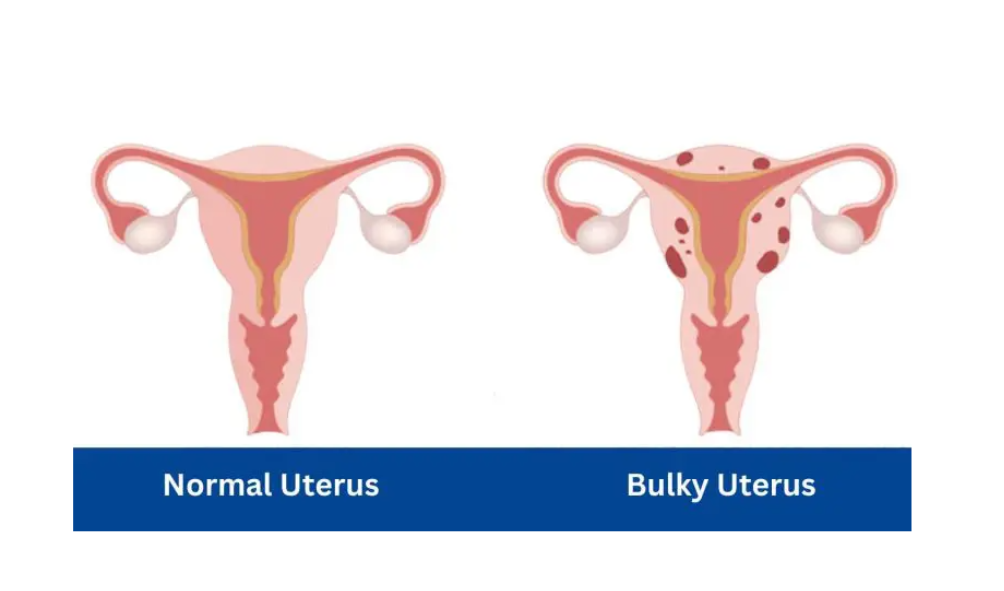Uterine health plays a crucial role in a woman’s overall well-being, as the uterus is responsible for nurturing the embryo and providing a safe environment for the baby during pregnancy. However, an unusually enlarged or bulky uterus in a non-pregnant woman can be a cause for concern and warrants medical attention. This condition may increase the risk of pregnancy complications and, in some cases, could be a sign of underlying health issues.
What is a Bulky Uterus?
In a non-pregnant woman of reproductive age, the uterus typically measures around 8 cm in length, 5 cm in width, and 4 cm in thickness. Slight variations may occur during menstruation, but a significant increase in size due to hormonal imbalances or reproductive system disorders can result in a bulky uterus. The volume of the uterus in normal cases can range from 80 ml to 200 ml.
Common Causes of a Bulky Uterus
Several conditions may lead to an enlarged uterus, including:
Hormonal Imbalance: Elevated estrogen levels, often caused by disorders such as Polycystic Ovarian Syndrome (PCOS), can cause the uterus to grow larger than normal.
Fibroids: These non-cancerous growths on the inner uterine lining can sometimes expand significantly, contributing to uterine bulkiness.
Adenomyosis: In this condition, the tissue lining the uterus grows into its muscular wall, resulting in uterine enlargement.
Endometrial Hyperplasia: This condition occurs when the uterine lining becomes excessively thick, especially during the follicular phase, leading to uterine growth.
Pelvic Inflammatory Disease (PID): Infections that cause inflammation in the pelvic region, such as sexually transmitted diseases, can lead to uterine swelling and a bulky uterus.
Pyometra: A buildup of pus within the uterus, often due to infection and obstruction, can also cause uterine enlargement.
Symptoms of a Bulky Uterus
Women with a bulky uterus may experience a range of symptoms, including:
Irregular or heavy menstrual periods
Pelvic pain and cramping
Vaginal discharge and bloating
Frequent urination
Constipation
Pain during intercourse
Heaviness in the lower abdomen
If you experience any of these symptoms, it is essential to seek medical advice. Early diagnosis and treatment can prevent the condition from worsening and help address fertility concerns.
Diagnosing a Bulky Uterus
Doctors may use various diagnostic tests to determine if a bulky uterus is present:
Ultrasound: A transvaginal ultrasound is often used to assess the uterus’s size and structure.
Hysteroscopy: This involves inserting a small, lighted tube through the vagina to closely examine the uterine lining.
MRI: Magnetic resonance imaging (MRI) can help detect areas of thickening or localized enlargement in the uterus.
Blood tests may also be necessary to identify underlying hormonal imbalances or infections.
Treatment Options
Treatment for a bulky uterus depends on the cause and severity of the condition. Options may include:
Hormonal Therapies: Used to address imbalances that contribute to uterine enlargement.
Pain Relievers: These may be prescribed to alleviate discomfort but do not treat the underlying issue.
Uterine Artery Embolization: This minimally invasive procedure reduces blood flow to the affected area, causing the uterus to shrink.
Surgical Treatments: In more severe cases, procedures like myomectomy (removal of fibroids) or hysterectomy (removal of the uterus) may be recommended.
Conclusion
A bulky uterus can develop gradually, often presenting symptoms long after the condition begins. Although it may seem concerning, it is treatable, and early diagnosis can help preserve fertility. If you notice any symptoms or have trouble conceiving, consult a specialist to explore the best course of treatment.
